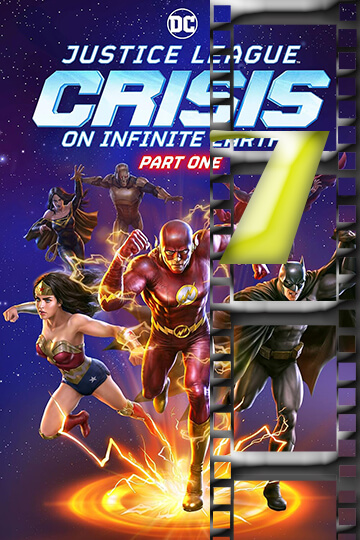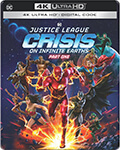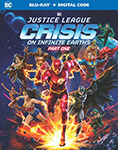


WHAT’S IT ABOUT
Based on the DC Comics storyline “Crisis on Infinite Earths” (1985–1986) by Marv Wolfman and George Pérez, the film is directed by Jeff Wamester from a script by Jim Krieg. It is the eighth installment in the Tomorrowverse, sharing continuity with the movie of the franchise that began with Superman: Man of Tomorrow (2020) and is the first part of a trilogy of films.
MOVIESinMO REVIEW
It’s the beginning of the end. Justice League: Crisis on Infinite Earths – Part One takes the DC universe into a cosmic showdown, delivering an Avengers-style superhero spectacle. Inspired by a classic comic arc, the storyline throws our heroes into a multiverse mess with evil doppelgangers and cosmic disasters. It’s like a superhero rollercoaster with a few quirks along the way. The constant jumping between alternate Earths can make it feel like a time-traveling treadmill at first, and the action scenes might trigger a bit of déjà vu from other superhero tales. However, as the story unfolds, it makes more sense, and the audience will root for the heroes to save the day. Although it’s called a Justice League movie, it mostly follows The Flash. The animation is top-notch, the voice acting is on point, and it lays the groundwork for what could be an exciting trilogy. Whether you’re a long-time fan of the DC heroes or new to the franchise, you’ll be able to jump right in and enjoy the movie for what it is: an action-packed adventure with some heart. The film’s pacing takes a bit as Flash hops through different points in his life. Something is going on, but it seems like a series of short, separate adventures from the Justice League’s early days that seemingly don’t connect. It’s not until around the halfway point that the scope of the threat is described in greater detail, and the multiverse comes together to prevent its destruction. Despite that, exploring those early days is still engaging. As we fully see how the Justice League first formed, it connects back to the post-credits scene from Batman: The Long Halloween and how Flash, Superman, Batman, and Green Arrow recruited their teammates. The non-linear structure of the story as Flash jumps back and forth between time points also adds to its intrigue into how certain events and characters are significant to the story’s potential conflict and resolution. As for The Flash, he is the central character of Part One and carries the film. Much of the plot hinges on his actions and emotional arc, particularly in his relationship with Iris. The Flash is often regarded as the heart of the DC Universe. With Flash’s humor, intelligence, and compassion, Bomer captures this in many ways. His performance is the film’s standout, and he shares many heartfelt moments between Flash and Iris, played by Ashleigh LaThrop. The pair has great chemistry, and it’s easy to see how and why Barry and Iris made such a great couple, even with the limited amount we’ve seen of them throughout the Tomorrowverse. At the heart of the DC animation is the love story between Barry and Iris West (Ashleigh Lathrop). Crisis on Infinite Earths walks us through their meet, wedding, and the end of their lives together while tethering them to the multiversal threat. Their relationship provides the film with its emotional throughline, helping to raise the already high stakes. Their moments are heightened by The Flash’s time and universe-jumping. I felt the gravitas at every turn, as though each minute they had together was a treasure worth holding onto, especially in the wake of the multiverse’s destruction. The DC animation captured the spirit of the crossover event that shook things up without forgoing any of the crucial narrative aspects. Not many adaptations can do that, but the film finds new ways to be exciting and intriguing. However, the story’s trajectory remains more or less the same for anyone who’s read the comics or even seen the Arrowverse version of Crisis on Infinite Earths. From the Justice League fighting Amazo (Nolan North), an AI hijacked by Lex Luthor (Zachary Quinto), to The Flash dealing with the Crime Syndicate, the film is the gold standard for balancing the multiverse and its many differences along with character dynamics. To that end, the use of the Monitor — a cosmic being — and Pariah, a mysterious figure who appears to The Flash throughout, is compelling. Their roles are elusive enough to leave the ending on a cliffhanger as we anticipate the next chapter of what will surely be an enthralling second installment, with the film laying the groundwork for what’s to come at the same time as it ramps up the tension and despair.
OUR RATING – A TOMORROWVERSE 7
MEDIA
- Genre – Comic Book
- Street date
- Digital/Blu-Ray/4K – January 9th, 2024
- Video – 1080p
- Screen size – 1.78:1
- Sound – English: DTS-HD MA 5.1
- Subtitles – English SDH, Spanish, French
Extras
- Crisis Prime(r): The filmmakers reveal in detail their intricate plan to create a comprehensive animated universe across seven films, a concluding with the events of the three-part adaptation Justice League Crisis on Infinite Earths.
- The Selfless Speedster: Explore The Flash’s legendary role in the “Crisis on Infinite Earths” comic series, the creative process that brought him to life in the animated adaptation, and the vocal performance behind his heroic and romantic story.

